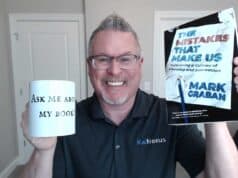We spend a lot of time here talking about how to prevent Lean failures and what some of the root causes are. I received a question from a reader that I thought I'd open to the group:
What are the biggest risks to successfully implementing a lean transformation in an organization, and what actions would you recommend to mitigate those risks?
Anyone have any recent or first-hand stories to share?
Subscribe via RSS | Lean Blog Main Page | Podcast | Twitter @MarkGraban
Please scroll down (or click) to post a comment. Connect with me on LinkedIn.
Let’s build a culture of continuous improvement and psychological safety—together. If you're a leader aiming for lasting change (not just more projects), I help organizations:
- Engage people at all levels in sustainable improvement
- Shift from fear of mistakes to learning from them
- Apply Lean thinking in practical, people-centered ways
Interested in coaching or a keynote talk? Let’s talk.
Join me for a Lean Healthcare Accelerator Trip to Japan! Learn More










It all comes down to leadership. If you have a department leader who has no interest in learning about lean themselves and less interest in leading it, all of the outside or internal consulting resources can’t “make them lean.”
Lean is not a delegated, hands-off activity. You must take an active leadership role. We implemented some great “lean tools” (changing the layout and improving the physical flow), but the area is struggling because of really lame, disinterested, uninvolved leadership.
If your idea of leading is to be in your office all day and have a nice friendly chat about the weekend once in a while, it’s time to retire or move on.
Don’t jump to inventory reduction before you have a solid foundation of problem solving and instructing. That can be a disaster. The customer must never loose as a result of your lean efforts. Protect them even if that means adding more inventory.
Along these lines, I’d say the biggest risk is jumping into implementing the lean tools. Stick with building a solid foundation of strategy deployment, problem solving, and standard work…do this and you can’t go wrong.
Also don’t think you can’t do it yourself. A big risk might be spending lots of cash on a slick consultant. Only you can generate results…nobody can come in an lean you out. You can do it…but you need good teachers.
1) Read “The Hitchhiker’s Guide to Lean – Lessons from the Road” by Jamie Flinchbaugh and Andy Carlino.
2) Just Do It.
Unfortunately there are no simple answers to what seems to be a simple question. Everyone’s situation is unique and you won’t learn what to do or what not to do by reading my response, Jamie & Andy’s book, or anything else.
What worked or didn’t work for me or someone else won’t really apply to you even if we’re in the very same industries with the same customers and the same suppliers and the same equipment and the same skills training program. The reason is because your people are not the same. You have your own culture and no book, tool, expert, or blog commenter can change your culture and become a continually learning organization. You have to do that from within.
That’s why no one has or probably will ever really copy Toyota. They don’t have Toyota’s culture which, by the way, isn’t a “Japanese” thing: there are Japanese companies who have tried and failed and some who are as wasteful as any western company, and there are some western companies who are very good but, again, they have their own culture and you have yours.
Experience will teach you, but only if you’re willing to start, only if you’re not afraid to fail, only if you’re able to admit when you’ve made a mistake, and only if you’re able to learn from your mistakes and are willing and able to show others how to do the same.
The previous responders have some good advice: it does require strong, committed leadership and only you can make it happen – outside help won’t get you there (books, blogs, or blowhards…I mean, consultants, like me).
YOU need to become a strong, committed leader (anyone can be considered a leader, you don’t have to have the word leader in your title or your job description) and YOU need to pick yourself up off the canvas each and every time you get knocked down and YOU need to carry on. If not You…who? If not now…when?
In other words, you need to Just Do It.
Follow Deming to be Lean. Few companies are able to succeed at copying Toyota because real Lean is not a cut & paste job. Trying to become as efficient as Toyota by duplicating everything it does, the typical approach to becoming “Lean” in the West, is just as bad as using a hammer to drive in your screws.
Deming’s work holds a large part of the philosophy that Toyota used to create the Toyota Production System.
Comments are closed.